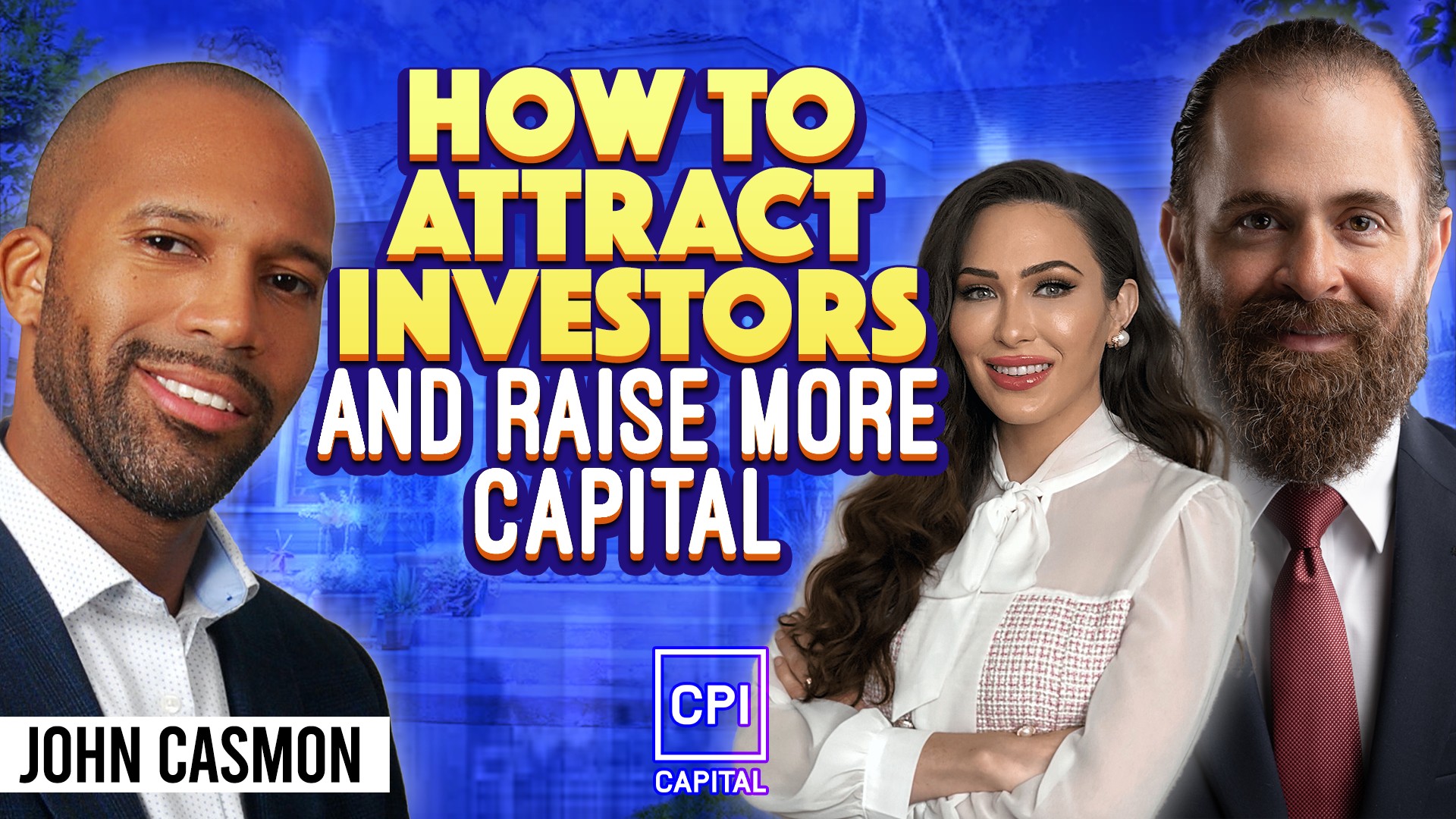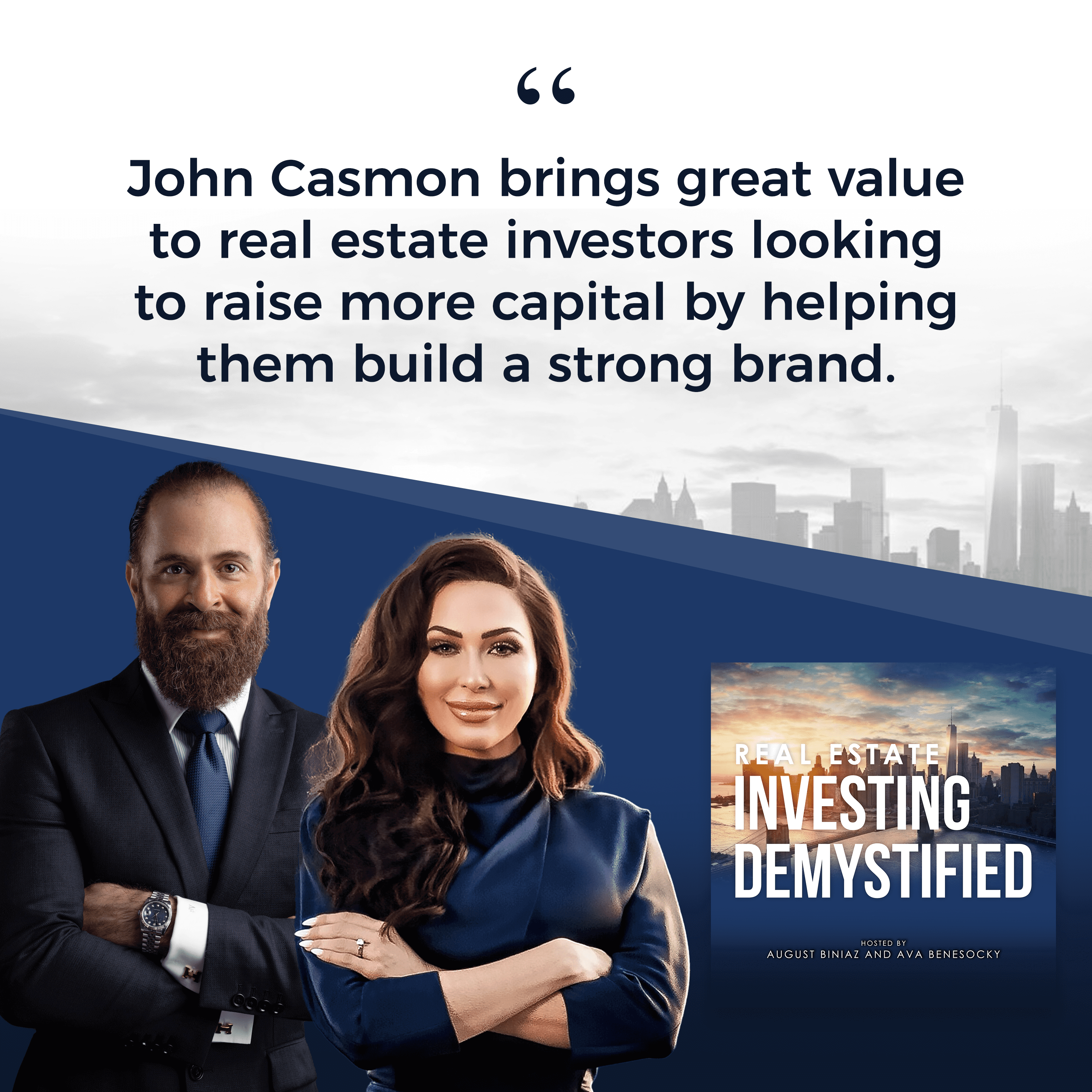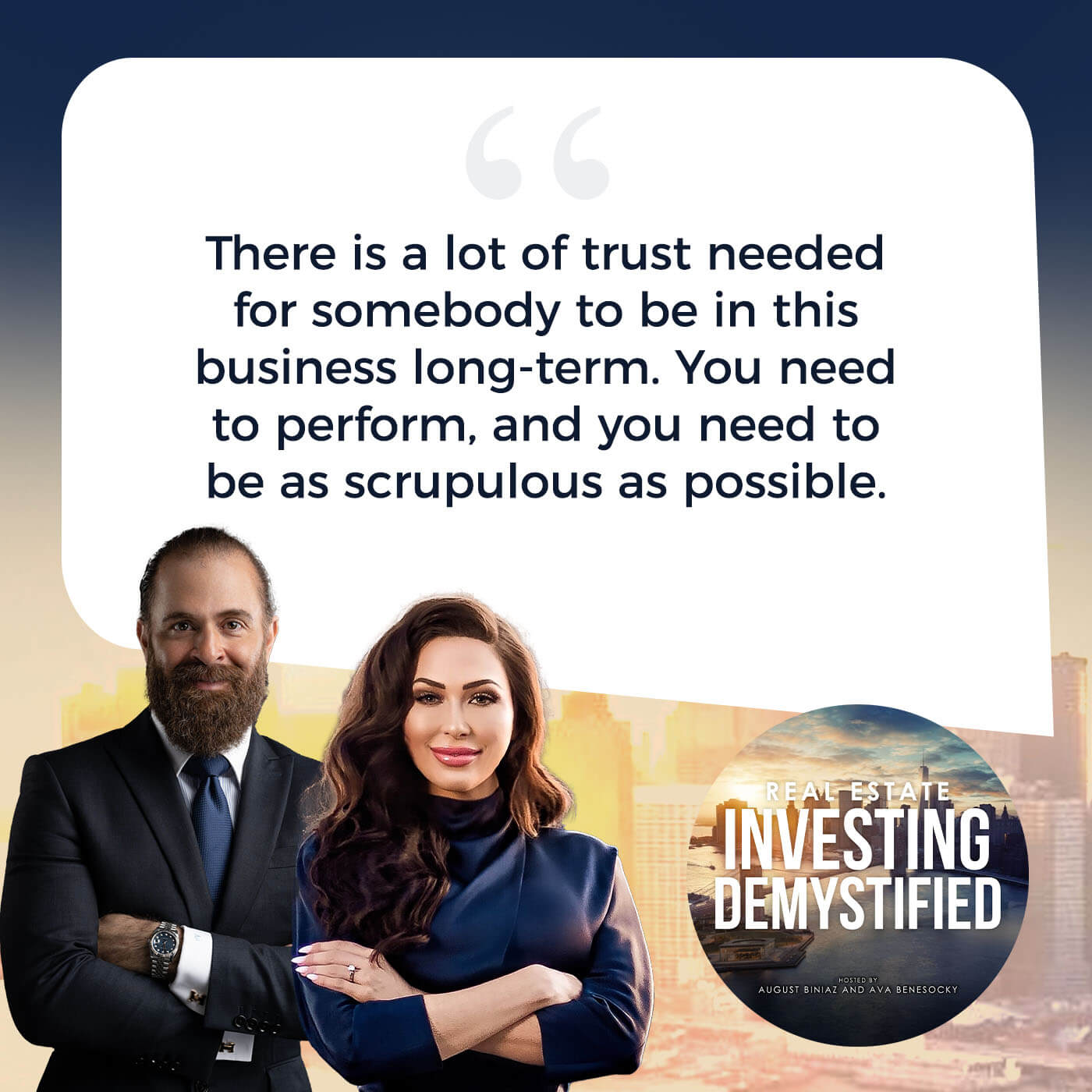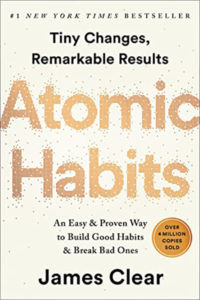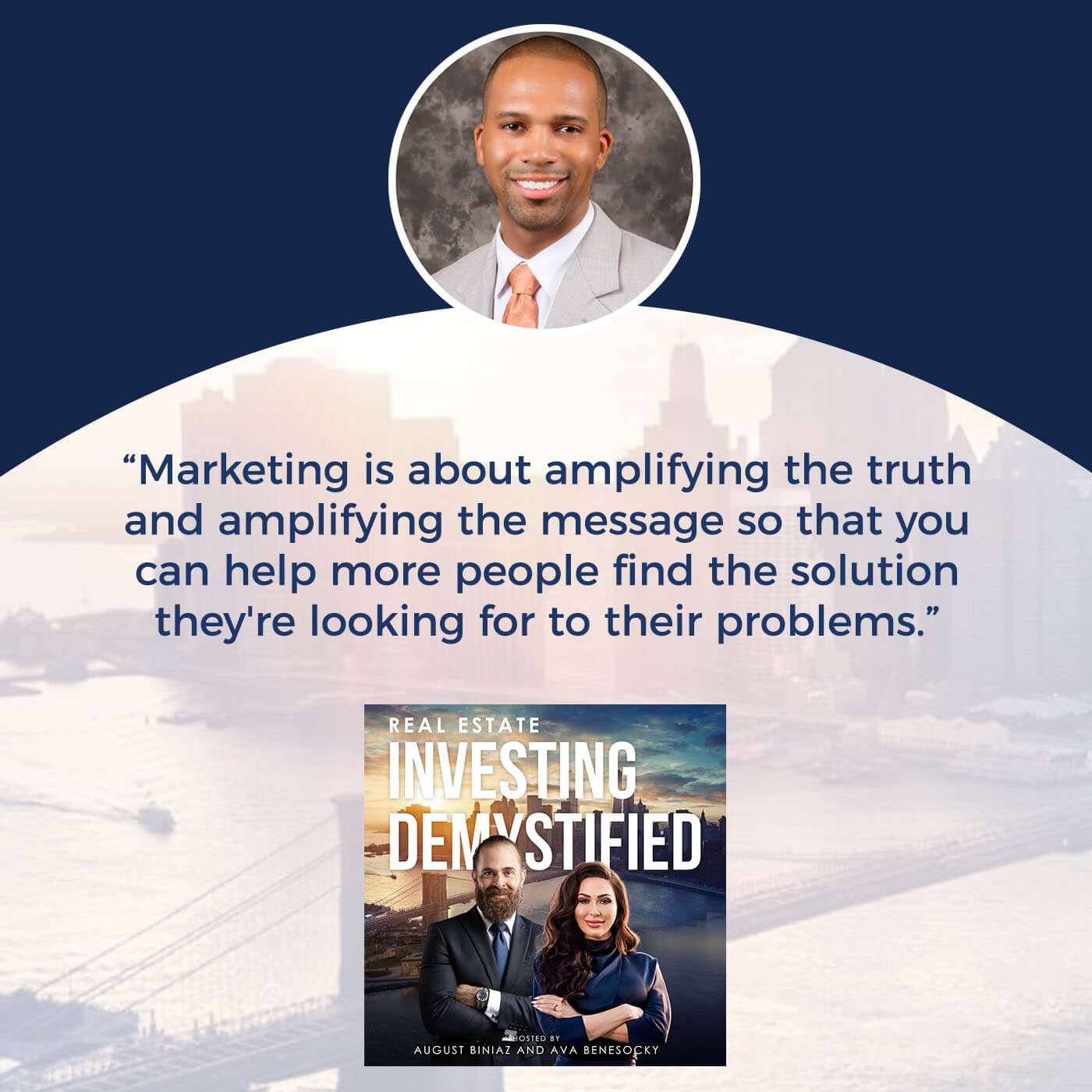A real estate investment firm needs equity, and equity comes from investors. So how do we get those investors and raise more capital? In this episode, John Casmon shares the tremendous job he made marketing Fortune 500 companies and how the marketing funnel can be the key to attracting investors for your firm. Tune in now and learn the journey an investor takes in partnering with a business, how that plays a huge role in determining your raise for equity, and more!
Get in touch with John Casmon:
Website: https://www.casmoncapital.com/
LinkedIn: http://linkedin.com/in/multifamily-apartments-john-casmon
Twitter:https://twitter.com/jcasmon
If you are interested in learning more about passively investing in multifamily and Build-to-Rent properties, click here to schedule a call with the CPI Capital Team or contact us at info@cpicapital.ca. If you like to Co-Syndicate and close on larger deal as a General Partner click here. You can read more about CPI Capital at https://www.cpicapital.ca. #avabenesocky #augustbiniaz #cpicapital
—
Watch the episode here
Listen to the podcast here
Important Links
- Multifamily Insights
- Midwest Real Estate Networking Summit
- Atomic Habits
- CasmonCapital.com/sampledeal
- https://TinyURL.com/54nsessu
- http://Linkedin.com/in/multifamily-apartments-john-casmon
- https://Twitter.com/jcasmon
About John Casmon

How To Attract Investors And Raise More Capital – John Casmon
We have a great show for you with a great guest. I’ve been personally on John’s podcast YouTube show, so I’m excited to bring our guest on and interview him. If you want to check out his show, it’s Multifamily Insights with John Casmon. Check that out. We’re going to get it started, Ava.
I’m going to introduce John here. I’m not only excited to tell everybody about who he is, but he also has a radio voice. Let me tell you guys a little bit about John. John Casmon is a real estate entrepreneur who has partnered with busy professionals to invest over $100 million worth of apartments. John also consults active multifamily investors to help them start or grow their businesses.
He hosts the Multifamily Insights Podcast, formally Target Market Insights, and is the co-creator of the Midwest Real Estate Networking Summit. Prior to becoming a full-time investor, John worked in Corporate America, overseeing marketing campaigns for General Motors, Nike, and Coors Light. We believe this interview with John will bring great value to real estate investors looking to raise more capital by building a strong brand. Welcome, John. Thanks for being on our show.
August and Ava, thank you for having me. I’m excited to be here. I appreciate all the warm compliments you gave me. I wanted to almost take that radio voice to another level in this episode just to accentuate it. It’s a fun thing that we can leverage some of the gifts, the technology, and the tools that we have to connect and engage with many different people. I’m excited to talk about real estate investing, a little bit about my journey, and how to tap into marketing to build a personal brand.
Maybe you can start by telling us about your background and your start in real estate.
You joked about the radio voice, but that’s actually what I wanted to do. I wanted to go on the radio. I remember being a young teen, and my uncle had a roommate who was a radio DJ. It was the first person I ever saw or heard who was in that space. His show came on at 2:00 in the morning. Very few times have I stood up or stayed awake long enough to hear it. It is just super cool to me. I got to college, I had a radio show, and I wanted to be a DJ. I realized that DJs starting out make pennies, almost below minimum wage, so I scrapped that idea completely. I did love marketing. I learned about communications and marketing. That’s what I studied.
I applied my degree and went into communications and marketing, working in advertising and marketing for about fifteen years. As you alluded to, I worked for big brands and big companies. I worked at General Motors in Detroit for about four and a half years. I worked in Chicago at an advertising agency, working on brands and campaigns for Nike, Coors Light, Mountain Dew, and some other big brands. While I was doing all that, I wanted to build a personal brand. For me, what happened during my time in Detroit at GM, which was from 2007 to 2011, for those of you who have no calendars and can’t look back at the time, was when the economic downturn kicked off. The company I was at was the face of an economic downturn, at least until the banks kicked in.
It made clear that you can’t depend on a W-2 job. You can’t depend on a company too big to fill or a job where you feel like you are secure because things can change very quickly. A lot of people are unfortunately experiencing that nowadays. We’re seeing a lot of tech jobs being lost and layoffs in various industries. If you are reliant solely on a W-2 job, you are exposing yourself to some of these issues. That’s what I saw with a lot of my colleagues. For me, watching that firsthand made me realize I need to insulate myself a little bit. As I read and studied more, real estate is the solution that kept popping up. I started to learn about real estate investing.
It took a little bit of time before I bought my first property. I ended up moving to Chicago. My wife and I bought a two-family that we house hacked. We lived in one unit and rented out the other unit. Once we had this proof of concept verified and had it validated, we were able to create six figures worth of equity in that first project.
That’s when I said, “This is what we need to be doing because I made more money in this project than I made in a year on my day job.” It’s like, “How do I do more of this and a little bit less of the W-2?” That launched my journey into what we do now, which is apartment syndication. We’ve partnered with busy professionals to join us on these deals. We have invested in over $100 million worth of apartments. That’s something that we do, but marketing played a key role in that. I know we’re going to dive into that a little bit more going forward.
I’ve been preaching forever about how important marketing is when you try to run a real estate investment firm.
Before that, John, you said a couple of things that I like. You can’t rely on your W-2 job. I have conversations with investors every day, and it’s all of our conversations. We’re trying to say, “How can we create alternative streams of income for yourself and your family, so you don’t have to have that pressure and you know you’re going to be okay?” I love that you said it’s all about the mindset, and people don’t know what they don’t know. Those are good points you made there.
The timing too, Ava. A lot of times, people want to get into this to quit their job. There’s nothing wrong with that if that’s what your goal is. It took me almost eleven years from the time I mentally said, “I need to diversify into something else.” From the end of 2008 to the time I left my W-2 job, it was eleven years. I started investing in 2012. It was a slow process to slowly start building up that portfolio, the passive income, and get to the point where I said, “Now I know how to make this transition to make this leap.”
Part of it is you have to have a plan and start working on that plan. Don’t expect it to happen overnight. Don’t expect it to be a one-year transition. It’s okay if you love your job and you can never envision leaving. You should still be investing because ten years from now, your situation may change, and now you’re in a position where you want to make that transition. I believe it’s important for everyone to at least give yourself options and mitigate your own personal risk as much as possible.
You have to have a plan and start working on that plan. Don't expect it to happen overnight. Click To TweetJohn, I want to make the connection between real estate syndications and marketing. How important is marketing for real estate investment groups who are relying on raising capital?
Initially, I had no clue that marketing was very important for real estate investing because, to me, real estate was brick and mortar. It was construction, it was development, and it was property management. It took me a while before I realized that everything I was doing in my day job was helping me grow a bigger business. What helps is understanding the different elements.
There’s the real estate, the construction, and the property management side of it. When you start breaking all those things down, it comes down to being able to manage people. Real estate is a business just like any other business. In that case, every business has the product or service you’re offering. You have to have some quality products or services, an operations team, human resources, sales and marketing, and finance teams.
In sales and marketing, when it comes to apartment syndication, there are two core components. One is going to be raising capital or attracting capital for deals. That’s going to be investor relations and making sure you’re building connections with people who want to invest with you, and the other is going to be deal flow, like acquisitions, finding deals, and how you are getting these deals coming in. Those are the areas where marketing can help you because now you understand how to build a pipeline, how to create funnels and how to engage with people so that they want to invest with you.

Attract Investors: Acquisitions, finding deals, and how you get these deals are the areas where marketing can really help because now you understand how to build a pipeline, create funnels, and engage with people, so they want to invest with you.
Similar to any other brand or any other company, you have to ask yourself, “If our business is driven by investors, how do we add investors? How do we connect with investors? How do we answer the questions that they have?” It’s just like any other business. If you had a cupcake factory, you’d want to understand, “Who are we selling these cupcakes to? What do they look for in cupcakes? How many cupcakes should we offer? Who are our best customers for cupcakes? How do we get in front of them more?” There’s a whole process, no matter what product or service that marketing helps you with. Sometimes people hear marketing, and they just hear advertising and promotion. Marketing is every single thing that you do to put a product or service in front of a customer so that they can make an informed decision.
There’s the location. Where are you offering this opportunity? How are you pricing it? What are their projected returns? How you are promoting it is going to be a piece of it. All these different things come into play, but you also have to understand the other options and alternatives. Sometimes people may look at us. You guys are syndication group, we’re a syndication group, and we’re here doing a show together. This doesn’t happen in any other industry. If I were a fitness coach and you were a fitness coach, we might be competing for the same client. Maybe we’re not going to sit there and collaborate on this. It happens because the competition is not each other.
The competition is anything else you could do with your money. We know that the stock market, crypto, and all these other options, saving it in a bank account, putting it under your mattress, and spending it completely, are the things we’re trying to help people with. It doesn’t matter if you invest with our group or your group. Certainly, we’re happy if you invest with us. We want to make sure people are educated so they understand how to take control of their finances so they can create the lifestyle they want for their families. Those are the things that we’re talking about with marketing. You’re trying to understand how you connect and engage with people so that they understand what it is that you do. This is still new to many people, and we have to spend a lot of time educating them. They know how the stock market works.
That’s a super important point, John. You talked about a cupcake factory or made an example of pizza. You know who your customer is. Your customer is someone who understands pizza and has had pizza before. You just happen to be a pizza shop that’s nearby, or you have a certain type of pizza.
Fair enough. You market it in conventional marketing ways where you get your product in front of them. In our industry, people who invested as LPs in the past understand the syndication model and have invested in these types of investments. The conversion rate is much higher there because our product is superior to REITs or other types of investments.
You also have a demographic who don’t even know this product exists, and that’s the majority of people. These are alternative investments because the standard is going through financial advisors and conventional ways of investing. We offer this other product that yields higher returns. It’s much more intimate and hands-on, but many investors don’t even know they could have even invested.
Just like large institutions, university endowments, pension funds, and family offices invest with large private equity firms like Blackstone, a doctor, a lawyer, or an accountant could come and invest with us on a very low point of entry of $100,000 and invest in our product and have the same type of returns that these large institutions have. The education and the marketing are for people who are in this space and want to eat the cupcake. It’s also to people who’ve never tasted cupcakes or even new cupcakes existed. That is our job, and that’s what we’re doing, creating content to even know our product even exists.
Think about the cupcake thing. People understand cupcakes. What if I told you that there was a cupcake that had zero sugar and it would help you lose weight? That’s counterintuitive to what people think of cupcakes. The challenge is you have to get in front of people to help them understand how this works, and in some cases, it’s almost like you have to reprogram people because, in their minds, real estate is one thing. Maybe that’s flipping houses or buying rentals and being a landlord.
That’s what they think of when they hear real estate investing. Maybe they’re against that. Maybe they don’t want to be a landlord. Maybe they try to flip, or they love watching those, but they have no desire in the world to be the person on the other end of that managing that project. They may be shut down from real estate investing. You have to take a moment and deprogram them to educate them on what it is that you do, how you can invest in these deals, be a direct owner, and get all the perks of owning real estate directly without the headaches of being a landlord.
That’s a conundrum that a lot of people have a hard time wrapping their heads. The challenge is breaking that down so they understand the nuances of it. Someone said to me once, “John, this sounds great. How come I’ve never heard of this before?” Think about it. You’ve got these big institutions, Charles Schwab, Northwest Mutual, TD Ameritrade, all these big companies. We just talked about marketing. They got big budgets, TV campaigns, radio, and digital.
There’s also a lobby. We are the alternative. People can take their whole life savings and go on the equities market and buy some Bitcoin or stocks, but if they want to invest $50,000 with John or August and Ava, they have to jump through million hoops and follow certain regulations. That’s another part of it as well, John. It’s the lobby.
You’ve got to understand that in this space, it’s more nuanced because you are working with direct groups, and you’re talking to them directly. The reason you may not have heard of this or you don’t see it as broadly is because you don’t have companies that have $100 million marketing campaigns or marketing budgets to go out there and tell everybody about syndications and all those things.
It’s one of those things that is a bit nuanced, but the people who can take advantage of this, it’s important for them. This is a fairly accessible thing for any professional. If you are a professional and make a decent salary, you don’t always have to be a credit. There are many deals that require you to be a credit, but there are deals where you don’t have to be a credit. Just continue to learn and educate yourself, and there are some opportunities that could help you and your family.
Now let’s keep going on this concept of marketing and getting our product in front of investors. Let’s go through an investor journey like we talked about, a cupcake shop. The first thing is the investor or the customer has to realize that store or that investment firm even exists. That happens through conventional and creative marketing strategies.
Now that they’ve connected, they now have to find a group interested enough who might want to be involved. Ava has a series of questions she’s going to be asking you. Walk both our passive investors who are reading and active investors to see the journey an investor takes from the time they realize a company investment firm exists to the time that they subscribe to their information and everything else.
It’s mind-blowing how many digital tools real estate private equity firms need to be efficient. Maybe we can give a crash course to our audience on a journey an investor goes through. First, we start with what August mentioned, that the investors realize that there’s an actual investment and that even an investment firm exists. The firm has to exist first. How would we do that, John? How would we get our brand or offering in front of investors? What are some of the strategies you’ve utilized or seen other groups utilize?
It’s important for people to understand the marketing funnel. This is true for any product or service, but the marketing funnel and picture an upside-down triangle. Up top is going to be the widest layer, and then it gets skinnier as you go down to a little hole where the final piece will come out. The top part of that funnel is awareness. How many people are aware of your product? For this case, I’m going to use Adidas. Think about Adidas. Are you aware of Adidas?
I normally use Nike, but I’m moving to Adidas for this one because Nike has some challenges too. Adidas, are you aware that they even exist? Are you aware that they make shoes? Most people are 98% to 99% of people are aware Adidas exist, and they wear shoes. The next part of the funnel is going to be a consideration. They make shoes. Would you consider buying these shoes? Maybe you would. Maybe you won’t. Maybe that’s 65% to 70% of them would consider buying them. Then there’s going to be trial. Have you ever bought them? Would you buy them one time? Would you try them on? Would you wear them for a weekend? Would you try them?
Once you try them, the next is going to be repeat. This funnel’s getting smaller and smaller. You have to try them before you can repeat. You try them, then you repeat. After you repeat, you become loyal to them. This is your favorite brand. You only wear or prefer Adidas. That’s your loyalty. Let’s take this back from what we’re talking about as multifamily investors or apartment syndicators.
First, they have to be aware you even exist. There are two things to think about when I say that. It’s not that you exist as a person. It’s understanding what you offer. Let’s go back to Adidas. You know that they make shoes. What if I told you that Adidas makes telephones? They make cell phones now. You may not know that they make cell phones. You know they make shoes, but you may not know and are not aware that they make cell phones. It then comes to, “Now that I’m aware, how do I make them aware?”
People have to be aware you even exist. It's not that you exist as a person; it's understanding what you offer. Click To TweetYou can tell them through a TV. You could tell them through a radio campaign or print. You could have some celebrities showcasing their Adidas phone. There are lots of different ways to start building awareness. As a multifamily syndicator, we have to let people be aware of what it is that we do and how we can help them. One of the ways I do that is by coming on a show like this. We’re going to talk to people, Casmon Capital Group Partners, with busy professionals to invest in departments passively.
We’re going to do it through a podcast, blogs, or social media. I’m going to do it through events and networking and showing up at these different conferences. I’m going to do it using email marketing. I’m going to email people and share information with them. I’m going to do it the old-fashioned way, word of mouth. I’m going to pick up the phone. I’m going to call some people. I’m going to text some friends. I’m going to share what I’m doing. These are all different strategies of things you can do to drive awareness of what you’re doing. A great way of doing this is when you buy a property, and you see this all the time on social media.
You buy a property. Why don’t you tell people you bought a property? Here’s one little tip. If you’re going to share that you just closed a property, make sure you do it in a way that is legal and not fishing for new investors, but you’re adding value to other people. One of the things that I always like to do, and I share this with all my coaching clients and other people as well, is when we do a closing, or we have something like that, we like to create an informational or an educational post about something we learned in that process or something that was reiterated to us.
We recently sold a 28 unit. It’s a smaller property in our portfolio. That was a JV deal, and we wrote an article about three lessons we learned about how being a seller informed our process to be better buyers. That was something that we shared. It’s not just saying, “We sold this. We made a ton of money. We’re ballers. We’re so great,” but taking a moment to educate people so they can learn from your experience and then apply it. You and I could sit there and say, “You bought this. I bought that.” That doesn’t add any value to anybody. It’s the same thing if you’re a real estate agent, “I sold 123 Main Street.” Who cares?
That’s great for you, pat on the back, but if you can demonstrate how you added value, how you’re separating yourself from your peers, and how you truly are a cut above, now you’ve added value. If you say, “We sold 123 Main Street. It went 20% above market, and it closed in 35 days. This is the fastest sell in this market. My clients are extremely happy. They had a tough situation. I was able to help them navigate it. If you’ve got a similar situation, I’m happy to talk to you about it.” now you’ve demonstrated your expertise. You’ve demonstrated how you navigated the market. You’ve demonstrated how you’re able to deliver for your clients.
You didn’t just say you closed, but you talked about the market knowledge and some of the challenges that you’re able to overcome. If I’m that person who’s sitting there thinking about selling my house, but I know it’s going to be a little crazy because we got a couple of issues to work through, who do you think I’m going to call? It’s that kind of thing on the awareness.
I spend a lot of time there, but that’s awareness. You got to communicate the awareness. Next is going to be consideration. Now that I’m aware that you’re a multifamily syndicator and I consider investing with you, you talk about know, like, and trust. This is where that comes in. This is the first time I’m seeing and hearing you. We’re not talking about buying a pair of shoes or buying a cupcake. We’re talking about a $50,000 or $100,000 investment. It may take a little bit of time for me to get to know you, to like you, and then trust you as a multifamily investor.
Now we’re going to go through that process to build that trust. This is where that engagement kicks in. This is why it’s important to build a list and start to share it with people. What’s great about a podcast is someone can listen to you for a long time and get comfortable with you before they’re ready to make that decision. As a matter of fact, on our most recent deal, I had someone reach out to tell me that they had been listening to me for over a year.
They were extremely comfortable with me. They had been on my newsletter list, but we had never had a live phone conversation up until that point, and they reached out to say, “I’ve been ready to invest. I’ve just been waiting for the opportunity to partner with you. I’m excited to work with you on your next deal.” It’s one of those things where they get a chance to build that consideration, then ultimately make that leap into working and partnering with you. Those are the things that are important.
You’ve got to find various avenues to get in front of people, but then you have to make sure you’re nurturing those relationships so they can get comfortable. You all have your thought leadership platforms with the podcast and the YouTube channel. There are people who are watching your YouTube channel and have been watching you for quite some time. Maybe they weren’t ready when they first started watching, or they had no idea what they were going to get into. They didn’t know if they were going to like you. They just liked August’s amazing beard and Ava’s colorful shirts, then they kept watching and finally decided, “I want to do something with them at some point. I’ll try it. I’ll let me invest with them and see what happens.” That’s what happens. People build it up, and then they try to partner with you. That’s the trial phase. If they have a good experience, that’s when they’ll come back and ultimately be a loyal investor.

Attract Investors: You’ve got to find various avenues to get in front of people, but then you have to make sure you’re nurturing those relationships so they can get comfortable.
It’s so much wisdom and knowledge there. I love that. I wrote that down. I’m going to be using it. Here are a couple of rapid-fire questions. In the concept of funnel, you got to be noticed. You talked about having your own YouTube show podcast. You talked about speaking on other people’s YouTube show podcasts. You talked about blogs, word of mouth, and events. You do all of these things on top to connect with investors. You’ve connected with them. Now they’ve noticed you. They’ve subscribed to you, hopefully.
Maybe you can touch on that in ways that they would subscribe to. Let’s say they’ve seen our show you talked about in our business lead magnet. Maybe you can touch on that briefly. They watched the YouTube show. What was the next step? They’ve checked out our website. Is that website enough for them to want to subscribe to us? Touch on this idea of subscribing to us and staying in touch with us concept.
There are two ways to look at it. We could look at it from our standpoint as the marketer, or you can look at it from their standpoint as the customer or the investor. As a marketer, yes, in our world, we want to put something out there, let them subscribe, consume all the information we have, and ultimately be ready to be a client or a customer with us.
The reality is that person on the other end is searching for something. We don’t always know what that something is. When they come to your website, you don’t know what they’re looking for. Maybe they’re already investing in apartment syndications, and they heard of you and want to check you out. They want to check out your website and see if it’s worth being on your list. Maybe they’ve never heard of this before. They were googling something and stumbled upon your website, but they’re not ready to join anything yet because they’re still just getting information.
What you’re talking about is when someone comes to your website, what’s going to keep them there? What’s going to make them engage with you? What’s going to make them say, “I want to be a part of this community or learn more from this community moving forward?” Something called a lead magnet is a great tool. Essentially all that is it’s something of value that you’re going to create, and you’re going to provide it to people who come to your website in exchange for their email address. On our website, we have a lead magnet, which is a sample deal package. It’s going to be a sample deal that we put together. Whether you’re an active investor or a passive investor, you can go to this website and download this package.
The reason we put it together is simple. For active investors who are looking to put together their own deals, sometimes they don’t know what should be in there. If you’re trying to compete with other people and you put together a deal package that’s skinny, and you don’t have a lot of key information in there, people may not take you seriously, or they may have a lot of questions. The more questions they have, the more questions they’re going to have.
If you’re not in a position to answer them, that’s probably going to lean towards not investing with you. Being able to take a look at a deal package allows you to look at it and, quite frankly, steal from what we’ve already put down there so you can learn what information you need to gather about the market. What do you need to talk about with the deal structure? What key phrases or information do you need to brush up on? What are the key highlights of the deal that you want to talk about? Who’s the team? How’d you come across this deal? What’s the story?
All that can help you if you’re an active investor. If you’re a passive investor, the challenge is the first time you see a deal, it may be a real deal. It may be someone, a group like mine, or yours who’s presented a deal, and now you’re trying to process everything at lightning speed, and you may not even understand some of the terminologies. Here you are trying to decide whether or not you want to invest in this deal, but you’re trying to figure out what in the world IRR means or what in the world some other phrase means that’s in this deck. It may just be a lot, and it could be overwhelming for you. What this does is it gives you a chance to take a look at it, understand what kind of information you should expect, and ask some questions.
What should you be looking for? Some of these deal packages are 25, 35, 50, and 60 pages long, and that’s before we even get to the PPM, Private Place Memorandum. This is just the marketing deck. If the marketing deck’s 50 pages, that’s a lot of information. What in the world are you supposed to pay attention to? How do you know which numbers mean something? Which numbers connotate risk versus numbers that are just numbers? This allows you to figure out what to pay attention to as well. That’s what we have as our lead magnet. It’s a tool to help people who are ready to invest.
The one thing I’ll say is you want to understand who your audience is when you’re putting this together. For us, our audience is someone who is very interested in multifamily investing. It’s not the person who woke up and said, “I got a lot of money in the stock market. What should I do with it?” For that person, you may want to start earlier in the process. They’re not ready to look at a deal just yet. They might need something that says, “Here are some great alternatives to the stock market.” Maybe you do a lead magnet tied to that. It comes down again to understanding your audience.
Going back to the cupcake analogy, if you have a fat-free cupcake that helps you lose weight, that’s great for an audience of people who are looking for that, but if you have someone who just wants some cupcakes for a five-year-old’s birthday party, they could care less about that. You have to figure out what you are looking to attract and highlight and what will be an important message for that end user.

Attract Investors: You have to figure out what you are actually looking to attract and highlight and what’s going to be an important message for that end user.
John, I wanted to talk to you about tracking investors. An investor visited your website, and now you want them to also see you on Facebook. Is this even possible? Let’s talk about that.
What is it called? There’s Google Analytics, and you have all these things, but there are also tools and a marketing strategy that groups utilize that if somebody shows up on their website, somehow this thing tracks them, follows them around the internet, then puts a Facebook ad in front of them and do all this up.
What we’ve heard is for groups like us, that’s very powerful because we’re not selling a service and a product. We are offering a partnership. There’s so much trust needed there because you know it’s just not buying a cupcake. You’re putting your trust in someone, giving $100,000 to groups like us, and signing a 200-page document saying that if we lost your money, they can’t do anything about it. We take their money, we invest with it, we manage the project, they have no say, and then we sell it when we want, they have no say. If there is profit, they get 70%, and we get 30%.
There’s a lot of trust needed there for somebody to take that step. If you want to be in this business long-term, you need to perform and be as scrupulous as possible, but the fact is there’s a lot of trust there. Somebody visited your website, then they’re just on Facebook, and they see you again. It keeps building that trust. They see you on this podcast and see you having your own podcast. They see you on this blog. Talk to us about what all that is.
There are a lot of developments taking place in that space. Google and Facebook are the main two, but they do have the ability to track your usage across various websites and serve up specific messaging to you tied to that. Let me give you a great example. Have you ever been having a conversation with someone about anything, then magically, you go on Facebook, Instagram, or Google and see an ad pop up for it, and you’re like, “What in the world is this?”
I thought my friends were just paranoid when that happened.
It’s true. I’ll give you a great one. I was talking to my son. He’s playing soccer, and we’re talking about how he can get better at soccer and all that. Sure enough, the next time I go to Instagram, I get an ad for a dribble-up soccer ball. I’m a middle-aged man at this point, so they know that I’ve got a son who has this soccer ball, and there’s an ad geared up to me. I didn’t search for this. I didn’t Google it. I didn’t do anything. This is a live conversation I’m having. From a privacy standpoint, there are some growing concerns about the access that some of these apps have, but you’re right. The fact is, if you visit our website, you can put what’s called a pixel on your website.
This pixel, Facebook and Google have it. You can put it on your website, and that pixel will track the IP address and other websites they go to, then you can serve up ads to individuals who take certain actions. The cool thing is, as a marketer, you get to serve up ads based specifically on the different actions they take. For instance, let’s say you visit my website but only stay for ten seconds. Maybe the ad I gave you is more awareness base. I can give you more information because you didn’t get what you needed in five seconds.
Let’s say you clicked on our Join Our Investor List button and stayed on the site for a certain amount of time, didn’t join our investor list, or didn’t download our sample deal package. I could serve a specific message to people like that to say, “Download our sample deal.” It’s a reminder specifically of a sample deal. I’m not necessarily going to say, “Invest with John Casmon and the Casmon Capital Group,” but I might say, “I knew you were interested in this sample deal package because you went to that website.”
You went specifically to that link but didn’t fill it out. Maybe I served you up in that, or a message that reiterates that and gives you another chance to do that. There are different little techniques and tools that you can do to be more effective that way. On the flip side, it could be a little concerning for the user because if you’re a user, it seems a little strange that you were on this website, you decided not to do it, and then you get this ad telling you, “Here you go. Do it again.”
There is a little bit of privacy that you have to understand. There’s a balance between being aggressive and serving up an ad you think people want versus giving them the space to let them know that their privacy is there. That’s something happening at a federal level with some of these websites as well as a marketer, particularly with what we’re doing.
The reality is that you want people who are ready. You just want to be there when they’re ready and remind them that we’re here when you’re ready. You don’t want to be pushing them to join your list or invest with you. You just want to be a reminder more than anything else. There’s a fine balance of how you do it, but there are some techniques and tools. If you look up Facebook pixels or Google pixels, you’ll be able to learn a little bit more about how to use that for your website.

Attract Investors: The reality is that you want people who are ready, and you just want to be there when they’re ready.
John, as we mentioned earlier in your bio, you also advise and consult investment groups. In conjunction with the real estate private equity firm that you run, is that a service you provide? Do you come in holistically, look at everything someone in a group is doing, and advise them? Talk to us about the services you provide.
The short answer is yes. We talked about my background in marketing. It’s important for every investor in this space, and not just investors but every entrepreneur. You have to figure out your super skill. What is the one thing you do that allows you to shine and be better than other people in your space? As I mentioned, when I came into this space, part of my hesitation was I felt I didn’t understand real estate as well as all these other real estate people. Who am I to go out there and try to syndicate these deals when I’ve never done construction?
You have to figure out your super skill. What is the one thing you do that allows you to shine and be better than other people in your space? Click To TweetI’m terrible at laying tile. I couldn’t tell you if it should be $1.22 a square foot or $1.78 a square foot. Who are you to do that? Part of it is you have to invest in the things that you do know. I know how to manage people. I oversaw a $100 million advertising campaign and had seven agency partners. Some of them were in the digital space. I did not understand things like pixels and all that stuff several years ago, and they were talking to me about it. You have to understand how to get the information even when you don’t understand the nuances of the specific mechanics of how something works and how you lead people regardless of whether or not you are the technical expert or you’re just leading a team of people.
That was something that I had in my corner, then also the marketing expertise. What I realized was many people have a challenge understanding this marketing component. I consult people who are active professionals and some folks who are starting. Many of them are starting and growing, but the folks who have the core elements of multifamily down and need help with the marketing component are my sweet spot because we can hit the ground running and take a look at all the stuff we’re talking about with analytics, with understanding what’s working, and where are their gaps in the funnel. This is what I’ve done for several years.
I sat with big brands and looked at all of their stuff, and we said, “We’re doing a great job driving awareness. We’re having a great job driving people to the website, but our conversion sucks. People are leaving the website, and very few are signing up. How do we fix this?” That’s what we spent our time doing. We sat and spent our time analyzing what we saw, where the gap is, and how we correct it. I’ll go back to the example we said. If you have people come to your website, but no one’s signing up, you got a problem. I had this problem myself. This goes back to why we help people. We help these people because I was doing all this stuff, and I forgot I was a marketer.
I was just doing what I saw the people do, build the website, host the podcast, and go to events. I wasn’t seeing the results, and I had to stop and say, “Why am I not seeing results?” I said, “John, stop acting like everybody else. You are a marketer. Put your marketing hat on and figure out what the problem is.” Once I figured that out, I was able to solve it. My biggest problem back then, I had a bad lead magnet. I loved the lead magnet. I did, but my audience didn’t.
Do you know why I know that? It’s because they didn’t download it. I remember the lead magnet I had before. It was my former show, Target Market Insights. It’s not Multifamily Insights. Target Market Insights was all about how to find the best places to invest. Our lead magnet was, “Twenty-one hacks to help you find the best places to invest.” There are great tips in there. It’s a phenomenal piece. The thing is, we didn’t get a lot of downloads on that. When we switched from that to the sample deal package, we started to see it take off. The thing, too, as a marketer, is you have to step back and understand that you may be too close to what you’re doing.
You may need to step back and ask yourself, “What do I need to provide for my audience?” The kind of thing we help all of our clients with is understanding where the gap is, “Let’s analyze what you’re doing, what’s working, what’s not working, how you get better at it, and where you can shine.” There’s a big difference between having a mentor and having a coach. I had a guest on my show. He broke down the difference between a consultant, a mentor, and a coach. Those phrases seemed all interchangeable to me. I was like, “This is interesting. I can’t wait to hear what he’s going to say.”
His point was a mentor is going to tell you how to do what they did, “Here’s what I did, do what I did.” A consultant is going to look at what you’re doing and tell you what to do. A coach is going to look at who you are, what your skills are and what your weaknesses are and help you maximize those abilities. That may feel very nuanced. If you’re an investor, whether you have a coach or a mentor now, my point is you have to ask yourself what you’re missing and what you need.
A coach is going to look at who you are, what your skills and weaknesses are, and help you maximize those abilities. Click To TweetI got kids. I coach their team sports. I’m not coaching the kid who can dribble well and is very athletic the same way I’m coaching a kid who’s got two left feet and is trying to figure out how not to hit himself with the ball. You got to coach them differently so they can be the best they can be individually so they can help the whole team. That’s the thing. It’s not about you trying to do exactly what that person did. You’ve got a different skillset. You’ve got a different story. You have different elements that you can highlight. It’s taking a look at that and then helping you maximize your potential.
I’m probably going to be getting a call here from CPI Capital as a potential client.
John mentioned it. There is that one little tweak that he made with his lead magnet. It can be one little thing where maybe we’re doing a great job at everything else, but there’s that one thing.
Thank you so much for the wisdom, advice, and lots of golden nuggets there. We are going to move on to the next segment of our show.
It’s the Ten Championship Rounds to Financial Freedom. Are you ready, John?
Let’s go.
First question, who is the most influential person in your life?
I got to see my grandmother. My grandmother passed away many years ago. She was amazing. She’s just the person who gave me all the confidence in the world when quite frankly, I shouldn’t have had it and didn’t have it. She made me believe in myself in a way that only grandmothers can do, and she’s the most influential person for me.
More compliments to John. John, question, what is the number one book you would recommend?
It depends on where you’re at. I could go to a lot of places. The one I would say is Atomic Habits. It’s an easy-to-read book. It’s very inspirational. More importantly than that, it’s actionable. It’s one of the first books I read. You can read 1 or 2 chapters and stop and start applying it immediately and see immediate results. The book talks more about how to become the kind of person you want to be, as opposed to just theory and hypothetical ways to improve your life. Atomic Habits by James Clear is one of the books I recommend. I’ve got four copies here in my house randomly because I’ll pass them out and keep ordering more.
If you had the opportunity to travel back in time, what advice would you give your younger self?
I would work harder. One thing I didn’t understand was this is a concept that I’ve learned as an adult. You get out what you put in, and you have to just work a little bit harder I would’ve worked harder, particularly in high school, to be a better student, to be a better student-athlete, and to get the results that I was looking for and understanding that it wasn’t based on nature and natural ability. It wasn’t a fixed skillset. I had the ability to improve and to be as great as I wanted to be if I spent more energy invested in that. Spending more time investing in the things I wanted to get good at would’ve been the advice I’d give myself.
Focus. That’s what I would’ve said to myself too.
Next question. What’s the best investment you’ve ever made?
My relationship with my wife is probably the best one I’ve ever made. I’m going to go with that.
What’s the worst investment you’ve ever made, and what lessons did you learn from it?
I did a flip project when I was at the point where I knew I wanted to scale, but I didn’t know how to scale. That was absolutely the worst investment I made. Part of it was I was so eager to scale that I tried a couple of different strategies to make that happen. One was following a guy who was a friend of mine. He was starting to flip with this other partner. I met that partner. I had on blinders because I was so eager to just go to the next level. I didn’t see the red flags. There were lots of red flags there.
The guy didn’t intentionally do anything wrong. Nonetheless, we should have recognized those red flags and moved a little slower. My lesson to myself is you’ve got to stay accountable for all the decisions you make and the team members you partner with. One big thing for me is we are slower to partner. We try to take our time to get to know people and make sure we understand the way they think, the way they make decisions, and how they handle conflict. That’s important to us. We don’t invest with someone or partner with someone until we have a sense of how they handle conflict and the negative thing.
Everybody’s great when you first meet. We’re all going to put on our best face, but it’s like a relationship. You got to have that first fight. The first fight tells you what you’re dealing with. When you have that first disagreement, you don’t want to talk to that person. Now you have a sense of, “Is this a real partner for me or have we passed the honeymoon phase?” Try to wait on the partnerships to get past that honeymoon phase so I can understand who I’m working with.
Those difficulties you had on that deal build you to be a better general partner and the fiduciary for your current investors. That’s well-learned. Also, another thing my grandpa says about partnering and figuring out your partner is always going on a trip or traveling with someone who is looking to partner with because, at travel, when they’re away, they’re out of their element and they become the real self, so you can see.
Next question, John. How much did you need in the bank to retire now? What’s your number?
To stop syndicating completely, we’d probably have to have $50 million or something like that. I say that because what I’m thinking about is taking care of us for the rest of our lives. There’s a number that’s much lower than that, that we could live off of, especially if we had passive income and had income-producing assets that delivered it. For me to stop doing everything, it would have to be a sizable number.
If you could have dinner with someone, dead or alive, who would it be?
I’d love to have dinner with my grandmother. I’m thinking about her now. I’d love to talk to her and have her see where I’m at now. She’s just a great person to talk to. I’d have to go back to her.
If you weren’t doing what you’re doing today, what would you be doing now?
I’d still be doing marketing. I enjoyed it. A lot of people get into a career or profession that they want to quit and leave. I enjoyed what I was doing. The problem for me was just more so the politics around it. I’ve realized I enjoy working with entrepreneurs because it’s not about politics. It’s about results. This isn’t about the CMO of some big company standing in their seat for another twelve months so they can get this big bonus. Those were the underlying things that we were navigating and dealing with. Here it’s more about how you help people reach the results they’re looking for.
I loved marketing. Marketing gets a bad rep because people see it as almost manipulation, and that’s not true. You can’t make people see something that isn’t there. If you have a crappy product, eventually, people are going to realize you got a crappy product. You can’t put an ad together and make people love something that sucks. It is about amplifying the truth and the message so that you can help more people find the solution they’re looking forward to their problems.
Two things about marketing that I’m realizing is I have zero background in marketing, but it’s part of our lives. A couple of things I realized are marketers are like builders. They build these strategies and funnels. Essentially, if you’re enjoying building, you’ll enjoy being a marketer. People don’t realize that marketing is involved in every aspect of life, like politics or the military.
A lot of time, a strong military or a group, the uniforms they wear and the way they act is marketing. The news gets to the other country they’re looking to invade, and they get so scared that the troops start running away. Marketing is also huge in politics, like the way you come across and the way you market yourself. You don’t realize that a lot of times, marketing has such an important influence on our lives.
John Casmon, book smarts or street smarts?
Street smarts.
Street smarts all the way?
Yes, of course.
Ninety-eight percent of our guests have said street smarts. These are academics and lots of intellectuals.
Last question, if you had $1 million cash and had to make one investment now, what would it be?
I would probably be in passive apartment investment. I’m not just saying that because that’s what we do, but there’s great value in not having to do all the work and being on the LP side of the table, especially if you have a preferred return position. That general partner’s going to do everything they possibly can to deliver your return so they can make money. That’s where I would go. The thing is that real estate is tried and true. Every investment has some risk to it. Unlike crypto or stocks or some of these other spaces where your investment could go down to zero, with real estate, the value never goes to zero. It is a matter of understanding what’s the risk in the deal and going from there. It would be in real estate.
That’s amazing. With $1 million passively in syndication, you’re looking at close to $70,000 a year of passive income. Good for you.
It’s preferred and lower on the capital stack, so you’re protected.
John, can you just let everybody know what is the best way that they can get in touch with you, please?
We talked about the podcast. Multifamily Insights is available anywhere you look, so listen to the podcast. The other thing is if you are interested in that sample deal package we mentioned before, you can go to CasmonCapital.com/sampledeal. From there, you’ll get a follow-up email with the top seven things we look for in any deal we’re looking at or evaluating. You can get on our newsletter and check out more deals there.
John, you’re a wealth of knowledge. We appreciate you coming to our show.
We really appreciate it. Thanks for being here with us, sharing all your knowledge, and giving us your time. Thank you.
Thanks for having me. I look forward to talking to you and continuing to build on a connection.
